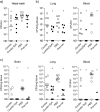A recombinant conjugated pneumococcal vaccine that protects against murine infections with a similar efficacy to Prevnar-13
- PMID: 30393571
- PMCID: PMC6208403
- DOI: 10.1038/s41541-018-0090-4
A recombinant conjugated pneumococcal vaccine that protects against murine infections with a similar efficacy to Prevnar-13
Abstract
The pneumococcal conjugate vaccine (PCV) strongly protects against vaccine serotypes, but the rapid expansion of non-vaccine serotype disease and the vaccine's high expense has reduced its overall impact. We have developed Protein Glycan Coupling Technology (PGCT) as a flexible methodology for making low-cost polysaccharide/protein glycoconjugates recombinantly in Escherichia coli. We have used PGCT to make a recombinant PCV containing serotype 4 capsular polysaccharide linked to the Streptococcus pneumoniae proteins NanA, PiuA, and Sp0148. The introduction of the Campylobacter jejuni UDP-glucose 4-epimerase gene GalE (gne) into E. coli improved the yield of the resulting glycoprotein. PGCT glycoconjugate vaccination generated strong antibody responses in mice to both the capsule and the carrier protein antigens, with the PiuA/capsule glycoconjugate inducing similar anti-capsular antibody responses as the commercial PCV Prevnar-13. Antibody responses to PGCT glycoconjugates opsonised S. pneumoniae and Streptococcus mitis expressing the serotype 4 capsule and promoted neutrophil phagocytosis of S. pneumoniae to a similar level as antisera generated by vaccination with Prevnar-13. Vaccination with the PGCT glycoconjugates protected mice against meningitis and septicaemia with the same efficacy as vaccination with Prevnar-13. In addition, vaccination with the protein antigen components from PGCT glycoconjugates alone provided partial protection against septicaemia and colonisation. These data demonstrate that a vaccine made by PGCT is as effective as Prevnar-13, identifies PiuA as a carrier protein for glycoconjugate vaccines, and demonstrates that linking capsular antigen to S. pneumoniae protein antigens has additional protective benefits that could provide a degree of serotype-independent immunity.
Conflict of interest statement
The authors declare no competing interests.
Figures






Similar articles
-
Intranasal Immunization with the Commensal Streptococcus mitis Confers Protective Immunity against Pneumococcal Lung Infection.Appl Environ Microbiol. 2019 Mar 6;85(6):e02235-18. doi: 10.1128/AEM.02235-18. Print 2019 Mar 15. Appl Environ Microbiol. 2019. PMID: 30683742 Free PMC article.
-
Direct Cloning of Bacterial Surface Polysaccharide Gene Cluster for One-Step Production of Glycoconjugate Vaccine.ACS Infect Dis. 2019 Jan 11;5(1):74-78. doi: 10.1021/acsinfecdis.8b00187. Epub 2018 Dec 18. ACS Infect Dis. 2019. PMID: 30445812
-
Pneumococcal conjugate vaccine for young children.Manag Care. 2000 Sep;9(9):49-52, 54, 56-7 passim. Manag Care. 2000. PMID: 11116663 Review.
-
Immunization with pneumococcal elongation factor Tu enhances serotype-independent protection against Streptococcus pneumoniae infection.Vaccine. 2019 Jan 3;37(1):160-168. doi: 10.1016/j.vaccine.2018.11.015. Epub 2018 Nov 13. Vaccine. 2019. PMID: 30442480
-
Pneumococcal conjugate vaccine (Prevnar; PNCRM7): a review of its use in the prevention of Streptococcus pneumoniae infection.Paediatr Drugs. 2002;4(9):609-30. doi: 10.2165/00128072-200204090-00005. Paediatr Drugs. 2002. PMID: 12175274 Review.
Cited by
-
The remarkable history of pneumococcal vaccination: an ongoing challenge.Pneumonia (Nathan). 2022 Sep 25;14(1):5. doi: 10.1186/s41479-022-00097-y. Pneumonia (Nathan). 2022. PMID: 36153636 Free PMC article. Review.
-
Conjugation Mechanism for Pneumococcal Glycoconjugate Vaccines: Classic and Emerging Methods.Bioengineering (Basel). 2022 Dec 6;9(12):774. doi: 10.3390/bioengineering9120774. Bioengineering (Basel). 2022. PMID: 36550980 Free PMC article. Review.
-
Efficient Production of Self-Assembled Bioconjugate Nanovaccines against Klebsiella pneumoniae O2 Serotype in Engineered Escherichia coli.Nanomaterials (Basel). 2024 Apr 21;14(8):728. doi: 10.3390/nano14080728. Nanomaterials (Basel). 2024. PMID: 38668222 Free PMC article.
-
Immunobiology of Carbohydrates: Implications for Novel Vaccine and Adjuvant Design Against Infectious Diseases.Front Cell Infect Microbiol. 2022 Jan 18;11:808005. doi: 10.3389/fcimb.2021.808005. eCollection 2021. Front Cell Infect Microbiol. 2022. PMID: 35118012 Free PMC article. Review.
-
Bacterial surface lipoproteins mediate epithelial microinvasion by Streptococcus pneumoniae.Infect Immun. 2024 May 7;92(5):e0044723. doi: 10.1128/iai.00447-23. Epub 2024 Apr 17. Infect Immun. 2024. PMID: 38629841 Free PMC article.
References
Grants and funding
LinkOut - more resources
Full Text Sources
Other Literature Sources

